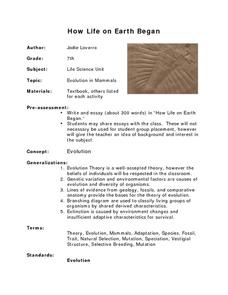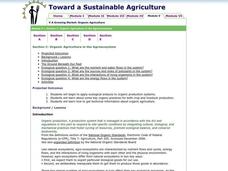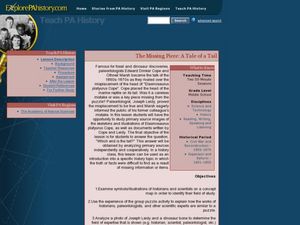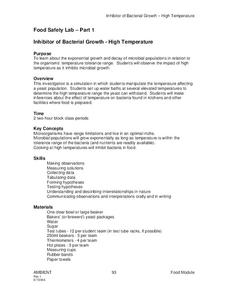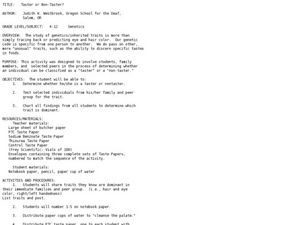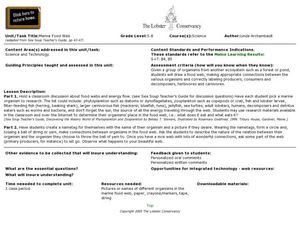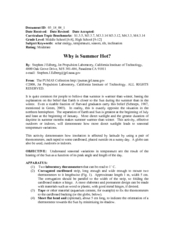Curated OER
Measuring Calories in Food
Students measure the amount of calories in food. In this food energy instructional activity, students discuss what a calorie is, how our bodies use a calorie, and how many we need. Then, students use a calorimeter to calculate the amount...
Curated OER
Corrosion to Corals
Students study galvanic exchange and how it produces electric currents. In this ocean lesson students predict what metals deteriorate in salt water.
Curated OER
Predator vs. Prey
Fifth graders participate in a game to become familiar with predators and preys. For this predator vs. prey lesson, 5th graders ascertain whether a photo shows an organism as a predator or a prey. Students read Killer Creatures....
Curated OER
Seed Types
Students dissect seeds. In this seed dissection lesson, students discover the anatomy of seeds. After dissecting seeds, students hypothesize and design the perfect seed to survive in a dry forest.
Curated OER
Introduction to Organs/Organ Systems via Frog Dissection
Students are to create, in groups of four, the insides of a frog. This is in preparation for the frog dissection that will follow this introductory lesson. Students can begin predicting what the inside of the frog will look like prior to...
Curated OER
Tectonic Plates, Earthquakes, and Volcanoes
Challenge geography classes to locate the major volcanoes and earthquake faults on a world map. In groups, they identify the pattern made and examine the relationship between the locations of the faults and volcanoes and tectonic...
Curated OER
How Life on Earth Began
Seventh graders investigate the concept of evolution and how it was a mechanism for the foundation of life on Earth. They conduct research and attempt to make cognitive connections with the evidence to agree with the presupposition of...
Curated OER
Relationships: Pressure, Volume and Temperature
Tenth graders investigate the relationships of pressure and volume and pressure and temperature of gases. In this gases lesson plan, 10th graders use an inflated balloon to show the relationship between volume and temperature of the air...
Curated OER
Toward a Sustainable Agriculture
Young scholars analyze organic production systems. In this organic agriculture lesson, students examine key organic practices for both crop and livestock. This lesson includes 5 different activities, 4 critical thinking questions and...
Curated OER
The Water Cycle
Fourth graders explore changes in water forms. In this water cycle lesson, 4th graders build a water cycle model and monitor it for 2 weeks in order to understand that water changes state as it moves through the cycle.
Curated OER
The Missing Piece: A Tale of a Tail
Students analyze and write about their findings of the dinosaur discoveries of Edward Cope. In this Edward Cope lesson plan, students examine illustrations of concept maps, discuss challenges, analyze skeleton diagrams, and write...
Curated OER
A Plant Begins
Students follow the growth of a plant from seed to adult plant. In this plant lesson, students watch the growth of a plant over time and record the changes to the plant. Students complete worksheets with their observations....
Curated OER
Barging Along
Students create a barge. In this technological design lesson, students use modeling clay to create a barge to hold marbles. Students make their barge then test it to see how many marbles it will hold. Students discuss why their design...
Curated OER
Keep Your Bubbles Up
Students investigate design and the correct use of technology. In this chemistry lesson, students investigate the Bernoulli Principle using hands on bubble making. They link the principle that keeps the bubble aloft to the BP principle.
Curated OER
Protect Your Melon
Students construct a helmet to protect their heads from falling objects. In this constructing lesson plan, students design this helmet with the lowest cost possible.
Curated OER
Cacao Tree Geography
Students use a map to learn about where chocolate comes from. In this lesson on the cacao tree, students locate various regions where the cacao tree grows. They will discuss why the cacao tree grows more favorably in particular climates...
Curated OER
Pilots, Airplanes, and the Tangent of Three Degrees
Students explore how to use trigonometry in the aviation field. In this aviation lesson students complete trigonometry equations that show what planes should do to land their airplanes.
Curated OER
Making Your Dog Your Best Friend
Students delve into dog training. In this biology lesson plan, students learn that hands, voice and heart is the basis of dog training and through demonstration and take part in a hands-on experience to teach a dog simple commands and to...
Curated OER
Food Safety Lab
Students determine the optimal living conditions for yeast and apply these results to microbes in food. In this microbiology lab lesson plan, students observe the reaction of yeast to elevated temperatures. They relate these results to...
Curated OER
Taster of Non-Taster?
Students investigate their own inherited traits by using taste papers. In this genetic traits lesson, students test their ability to taste various substances, which is determined by inherited genetic traits. They take home taste papers...
Curated OER
Marine Food Web
Students investigate the effects of the food chain on all animals by creating a food web. For this seafood lesson, students discuss energy flow and research a specific marine organism of their choice. Students create a food...
Curated OER
The Sum of All Thrills
Students make a bungee cord. In this potential and kinetic energy lesson, students work in groups to create a bungee cord for an egg. Students evaluate and test their cord. After performing the experiment the students answer...
Curated OER
The Moon Orbits the Sun?!?!
Students calculate the strength of gravitational force exerted on the moon by the sun and earth. In this orbital instructional activity students view a demonstration to see the gravitational forces between bodies.
Curated OER
Why is Summer Hot?
Students examine how variations in temperature are due to the Sun and length of day. For this solar lesson students complete a lab activity using thermometers and artificial sunlight to see how the earth is heated.






